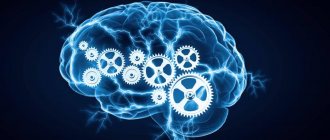Associative thinking operates with images that arise in a person’s memory. One idea (image) gives rise to another: this is how associations are formed. Any images, ideas and associations are a consequence of a person’s personal experience and knowledge. That's why they are different for everyone.
For example, the word autumn will be associated by some people with slush, by others with crimson gold-clad forests, and by others with melancholy and a feeling of loneliness.
What do associative thinking give us? It directs the thought process in the right direction, since incorrectly formed images can lead to mental illness in the future.
My neighbor takes her son to a psychologist for classes on the development of associative thinking to prepare him for school. It’s no secret that modern curricula are difficult to master even for adults, let alone children.
Find out what awaits you today - Horoscope for today for all zodiac signs
Due to numerous requests from subscribers, we have prepared an accurate horoscope application for mobile phones. Forecasts will arrive for your zodiac sign every morning - it's impossible to miss! Download for free: Daily Horoscope 2020 (available on Android)
What is associative thinking
Associative thinking - what is it? It is a verbal connection between two or more concepts. The subconscious mind works with information entering the brain without using the ability to conduct logical analysis. Associative thinking is associated with the perception of the surrounding world, the ability to make decisions and generate ideas. Its development depends on the attention, memory, and life experience of each individual.
What associative thinking is can be shown with an example. Let's say you met some new object or person. At this moment, your brain begins to actively operate. It compares what you just learned with what you knew before. At the same time, he creates associations. The next time you meet an object, you will recognize it thanks to the associations already fixed in the subconscious. The more of them there are, the easier it is for you to remember and analyze the situation.
And now a clear example. Imagine a person who saw the northern lights for the first time in his life. He compares it to something familiar, like fireworks or lightning. The sound that accompanies the phenomenon is similar to the crackling of wood in a stove. And so on. Having met a new acquaintance, a person will note that his voice is similar to that of a colleague. The face shape is the same as that of one of the relatives, and the gait is like that of a close friend.
Signs
Psychologists identify the following signs of creative thinking:
- speed of generating ideas;
- flexibility - generating an endless stream of ideas;
- originality - the uniqueness of ideas, their dissimilarity from others;
- detailing - important small details are added during the work process;
- emotional involvement in the problem being solved (as practice shows, an unmotivated person capable of creativity will not even begin to consider it);
- multifunctionality - the ability to do several things at once without compromising their quality;
- completeness - every idea and image acquires logical completeness.
Consequences of creative thinking and activity
Representatives of Gestalt psychology painted the following portrait of a person who is distinguished by a creative way of thinking (they call him a “creator”):
- is not limited by anything either in thoughts or in action;
- not blinded by habits;
- never repeats anything, especially after someone;
- does not act mechanically;
- does not take a one-sided, partial position;
- is unable to concentrate on what is not interesting to him;
- does not perceive the world and other people by their external standards and parameters, but always tries to look inside;
- not rational, not calculating, not indifferent and not indifferent.
Psychologists have even determined how the character traits of people with a creative mind manifest themselves:
- go against the standards of society;
- have a strong personality;
- very sensitive and vulnerable;
- underestimate their abilities too much;
- Even in adulthood, they remain children at heart.
So people who are inclined to creativity can most often be noticed without even conducting any additional research - their character will reveal them in any society.
Types of associations
According to the associative theory of thinking, different senses are involved in creating associations. Therefore, when a person hears a word, he almost instantly associates it with some object. For example, the characteristics “sweet”, “airy”, “creamy” remind him of a cake.
There are several types of associations:
- Contrasting, opposite to each other: fire and ice.
- Similar in meaning: veterinarian - doctor.
- General or generalized: lemon - citrus fruits.
- Those that subordinate other concepts: part - cog.
- Related concepts close to each other in time and space: meat - cow.
- Speaking about individual parts of the whole organism: eyes - face.
- Cause-effect associations: rain - umbrella.
- One word complements the other: porridge - butter.
There are other types of associations. They differ from each other in the method and conditions of use. They may have the same root (gloomy - gloom), be related phonetically (bump - bud) or relate to the same topic (cocktail - bar).
Benefits of Associative Thinking
Imaginative thinking helps in solving problems both in everyday life and in work, study, etc. This is just one of its advantages. There are a number of others:
- Promotes the development of imagination. As stated above, you will be more likely to have unusual but interesting ideas. It will also make it easier for you to be creative.
- Improves memory. Long associative chains are built in the brain, which allow you to remember a large amount of new material.
- Increases productivity. Everything is clear here. If you assimilate new information faster, you will complete the tasks assigned to you faster and better.
- Improves brain function. Another feature of associative thinking. During the construction of an associative series, new bundles of neurons appear in the brain.
- Makes it easier to understand. It is easier for you to perceive new data and connect it with the information you already know.
Another undeniable advantage is the opportunity to get to know your inner “I” better. According to Sigmund Freud, associations reveal what is hidden deep in a person's subconscious. Using associative thinking, you may discover information in yourself that will help change your life.
You can clearly see the benefits of associative thinking using examples. Engineer Brown, who was building bridges, once saw a cobweb under a bush. This prompted him to create a suspension bridge, the fastenings for which were cables.
Or remember Georges de Mestral, the creator of Velcro. He came up with it after examining the structure of burdock spines under a microscope. And he took it off his dog in abundance after every walk.
Diagnostics
You can take the simplest test for imaginative thinking. Look carefully at the images and try to see in them, in addition to the main subject, those that the artist has carefully hidden from direct view. The sooner you see them, the better.
Another test that will allow you to determine which type of thinking prevails in you and how developed your figurative thinking is. Read the statements, put pluses (checkboxes) next to those that apply to you.
Interpretation of results
Count the number of pluses (checkmarks) in accordance with this table and see how developed your imaginative thinking is compared to others.
If the NOM column contains up to 2 pluses, this is a low level of development, 3-5 is normal, 6-8 is high.
Associative thinking disorders
Deviations in the process of associative thinking are manifested in changes in its speed, focus, and correctness. Each group of disorders has several subtypes.
By change of tempo:
- A person processes information quickly. He also quickly and impulsively generates new ideas and makes decisions. Most often this is a sign of manic states.
- The speed of thinking slows down. Thinking about solutions to the problem takes a lot of time.
- Extraneous thoughts are introduced into the process, which interfere with the construction of associative chains. As a result, people get off topic.
- Due to the interruption of thoughts, thinking stops.
By liveliness:
- In the process, a person mentions too many minor details, unnecessary details.
- Many additional associations and nuances are given.
- Associative thinking becomes “sticky” and unproductive. The thread of the conversation is lost.
For grammar:
- In a conversation, a person speaks in cliched phrases, uses stereotypes and cliches.
- Words, sounds and phrases that are completely meaningless are constantly repeated.
- The interlocutor repeats incoherent, logically and grammatically incorrect phrases.
How to develop associative thinking
Associative thinking, like other types of thinking, can be developed. The main requirement in this matter is to regularly train by performing a series of simple exercises.
Work with children
It is better to develop this type of thinking from childhood. It is easier for children than adults to establish connections between objects, events and phenomena. How can we help them develop the ability to think in associations?
First, tell your child about the objects that surround him and what he can do with them. Then move on to generalization. For example, explain that plates, cups, pots are all dishes, and a sofa, cabinet and chair are furniture.
These exercises are suitable for young children. For those who are older, more complex tasks are needed. Invite your child to determine the correct sequence of objects or find one common feature in them.
Remember that associations will not always be positive. Sometimes children react sharply to one image or another. For example, they associate a white coat with a doctor, and the doctor himself with an injection, etc. Such associations are called suppressed. We need to get rid of them.
Exercises for adults
Regularly performing simple exercises will help you learn how to quickly create associative chains and remember information that is new to you.
- Take 2 words that are in no way related to each other. Create associations between them.
- Come up with 1 word with which you will begin building an associative chain. Select associations for it as long as you can.
- For this exercise, let's have 3 words. Select associations that match these words in some way. For example, you selected “bright” and “hot”. Think about what objects or phenomena might have such characteristics.
- For several initial words, select associations that suit each of them.
- Take 1 word and select an unusual association for it, which, at first glance, has nothing to do with it.
- Think about one of your friends. Choose a song that describes him best. Let this be the first thing that comes to mind. You can also turn on the radio or your favorite playlist, close your eyes and observe the associations that arise in your mind.
- Brainstorm. What it is? Take a piece of paper and write down on it all the words that come to your mind. Read the entries. Think about how these words are related to each other. Naturally, some of them will baffle you. Don't be scared and don't stop. Try to figure it out.
Recommendations
You need to exercise every day. The ideal option is a lesson lasting about 2 hours. It is recommended to start developing associative thinking with 20 minutes a day. Gradually increase the time.
Remember that bright, unusual, memorable associations work best. It is important that they are not only interesting. Let them touch all your senses. Associate objects and phenomena with smells, shapes, colors, etc.
According to psychologists, women have better developed associative thinking than men. Therefore, representatives of the stronger sex sometimes need help. Special creative notebooks have been developed for this purpose. By completing tasks in them, you can significantly improve your ability to build associative connections.
What are the disadvantages
Psychologists also warn about the dangers of figurative thinking.
The problem is that it can lead too far from reality, especially if it prevails over the action-figurative and verbal-logical. Children, captivated by their own images in their heads, begin not only to compose fables, but also to believe in them. And, if in children this imbalance is easily corrected with the help of psychotherapy, then with adults the situation is much more serious.
Firstly, many creative genius people, whose imaginative thinking is at a high peak of development, lose touch with reality and begin to imagine themselves as something like a deity. It seems to them that they are illuminated by light from above if they are allowed to see in ordinary things what others do not notice. The ego is inflated to incredible proportions, which leads to social maladjustment and various personality disorders.
Secondly, the most ordinary people, under the influence of images in their heads, begin to connect those objects and phenomena of the surrounding world that have nothing in common. This explains the belief in magic, witchcraft, and otherworldly realities. Hearing a rustling sound in the room at night, they imagine a real monster in every detail and deny the presence of mice in the house. If on the morning of Friday the 13th a salt shaker overturns and a black cat crosses the road, such suspicious people will begin to panic. And all because in their minds they will draw terrible pictures of the consequences to which all these superstitions will lead.
Another disadvantage is that there are not always enough words and figures of speech to describe the picture that takes shape in your head. Because of this, contradictions and misunderstandings often arise in everyday life. For example, a couple came to the store to choose textiles for the bedroom. One thinks that this color scheme will fit perfectly into the interior, while the other thinks that it will look too provocative and flashy. And all because they have different ideas about the same room. As scientists have proven, women see everything in brighter colors and, accordingly, choose the same things. Men are exactly the opposite.











